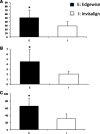Analysis of pain level in cases treated with Invisalign aligner: comparison with fixed edgewise appliance therapy
- PMID: 25416143
- PMCID: PMC4240829
- DOI: 10.1186/s40510-014-0064-7
Analysis of pain level in cases treated with Invisalign aligner: comparison with fixed edgewise appliance therapy
Abstract
Background: The aim of this study was to evaluate and compare the difference in the level of pain using the visual analog scale (VAS) between cases treated with the edgewise appliance and Invisalign. In addition, the cause of pain and discomfort in the Invisalign cases was identified.
Methods: The sample consisted of 145 cases for the edgewise group (EG; n=55), Invisalign group (IG; n=38), and edgewise and Invisalign group (EIG; n=52). VAS scores were collected during the first three stages (first stage: 0 to 7 days, second stage: 14 to 21 days, and third stage: 28 to 35 days) and at the end of the treatment (overall VAS score). Evaluation of the cause of pain was categorized into three different types of problem (category 1: non-smoothed marginal ridge or missing materials, category 2: deformation of attachments, and Category 3: deformation of the tray). Statistical comparison of VAS scores between groups was performed by two-way analysis of variance.
Results: A significantly higher VAS score was observed at 3 and 4 days after, at 1, 2, and 3 days after, and at 2 and 3 days after in stages 1, 2, and 3, respectively, in EG compared to EIG and IG. A significant difference was observed in overall VAS scores between EG and IG in intensity of pain, number of days that pain lasted, and discomfort level. Only intensity of pain resulted in a significant difference between EG and EIG. Most of the causes of problem in the Invisalign cases were deformation of the tray.
Conclusions: Invisalign may offer less pain compared to the edgewise appliance during the initial stages of treatment. In the use of Invisalign, deformation of tray must be carefully checked to avoid pain and discomfort for the patients.
Figures








References
-
- O'Brien K, Kay L, Fox D, Mandall N. Assessing oral health outcomes for orthodontics–measuring health status and quality of life. Community Dent. Health. 1998;15(1):22–6. - PubMed
Publication types
MeSH terms
LinkOut - more resources
Full Text Sources
Other Literature Sources
Medical

